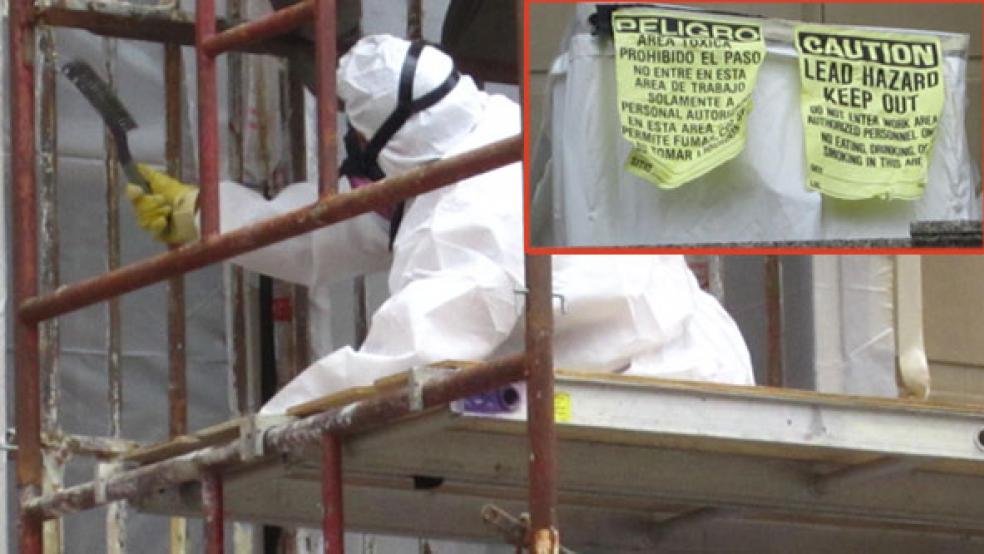When the Environmental Protection Agency issued a new regulation in April 2010 requiring housing contractors to take extra precautions around hazardous lead paint, businesswoman Kathy Faia followed it to the letter of the law.
One of her construction workers in Kenner, La., attended classes to become government-certified in the new procedures. She purchased expensive Star-Trek-like coveralls with goggles, rubber gloves, hoods and rubber boots for her workers. And she instructed her remodeling crews to literally enshroud houses they were working in a plastic bubble wrap to prevent lead paint flakes, which potentially can cause damage to the brain and nervous system, from escaping into the atmosphere.
A little more than than a year, Faia says her small, family-owned construction business is financially ruined. The new rule’s detailed compliance requirements, related paperwork, and purchases of EPA required equipment added thousands of dollars to the cost of doing business and made it much harder for her to compete for remodeling contracts. Business has dropped off by more than two thirds, and she recently had to lay off one of her workers. “I’m just barely hanging on,” she says. ““They [the EPA] are over-regulating and sucking all of the fun out of the remodeling business.”
Faia’s story is not unique, and it comes as conservative lawmakers wage a campaign against EPA’s rulemaking that they contend is destroying jobs and harming the economic recovery. EPA officials say the new Renovation, Repair and Painting (RRP) rule is important in protecting the health of construction workers and young children who are especially susceptible to the effects of lead paint in their homes.
Since the GOP took control of the House in January, there have been at least 159 votes on measures opposing environmental protections -- including 83 targeting the EPA, according to a list compiled by Democrats on the House Energy and Commerce Committee.
Last July the House Appropriations Committee voted to cut off enforcement funding of the RRP rule until the EPA recognizes a reliable lead-paint test kit. “This is exactly the sort of regulatory bungling that’s costing us jobs and slowing economic recovery,” says Rep. Denny Rehberg, R-Mont. “If the EPA is going to create a bunch of hoops for small businesses to jump through, the very least they can do is give them the tools they need to comply with the rules. While I support the underlying goal of reducing harmful lead exposure, we need to strike a commonsense balance that doesn’t put small businesses into no-win situations.”
The EPA’s promulgation of the RRP rule caused uproar in the home remodeling industry last year when experts and businesses claimed it would destroy jobs and small businesses. Interviews in recent days suggest that the regulation has hurt companies that closely adhere to the rule, but there is little evidence that the rule has forced large numbers of layoffs.
The regulation requires any renovations on homes built before 1978 to be completed by certified contractors and follow a stringent set of lead-safe work practices. According to the EPA, lead paint was used in 38 million homes before it was banned in 1978.
Interviews with contractors and industry advocates indicate that the relatively small number of contractors actually following the new rule are feeling an economic pinch while most other contractors are simply ignoring the regulation and hoping they won’t get caught and heavily fined. The fines could be as high as $37,500 per violation per day, but the chances of a contractor being caught and fined are negligible, because EPA enforcement is so lax.
“The rule has . . . expanded the underground economy in the construction industry,” said Shawn McCadden, an industry consultant and former remodeler in Massachusetts. The so-called “underground economy” includes contractors who have made a conscious decision not to get EPA certified.
“The ones who used to get the jobs aren’t getting the jobs,” McCadden notes. “It’s really making it unfair to those who are certified and it’s tempting contractors to jump into the fray of operating illegally just to survive.”
Contractors say they are reluctant to try to pass on added fees to homeowners when remodeling jobs are already scarce. The EPA estimates that the costs to contractors to follow the work practices range from $8 to $167 per job, with the “exception of those exterior jobs.” Industry experts insist the EPA is low-balling the added cost and say that the new regulation is adding 7 to 15 percent to the cost of a basic home improvement or renovation. Remodelers are afraid that once their company is registered with the EPA they will be targeted first for regulation compliance.
The president of a large Midwestern remodeler, who declined to be identified for this story because of his company’s involvement in a lawsuit, says his company spent $75,000 on training, labor, and materials and associated fees over the last year trying to comply with the rule. It was recently audited by the EPA for paperwork violations.
“We’re a significant leader in the industry,” he tells The Fiscal Times. “We are responsible workers and they audited us. Nearly 85 percent of our industry is untrained, and the EPA turned their resources on the good guys. The law is prohibiting me from serving my clients and it is driving my clients to uncertified contractors.”
EPA officials have declined to discuss the controversy over the new rule but say that it is relatively easy for a company to achieve EPA certification. Firms need to send in a two-page application to the EPA and pay a $300 fee for a one-day class with a 20-question exam. As of October, the EPA had trained an estimated 743,000 people in the construction and remodeling industries to use lead-safe work practices. They have certified 92,000 companies. Harvard University’s Joint Center for Housing Studies estimates there were more than 650,000 contracting businesses in the U.S. as of 2007, the last year for which data was available. Industry experts say the real number is probably closer to over 1 million businesses including independent contractors.
Last year, only 206 special EPA agents oversaw all lead-paint related issues throughout the country. The EPA relies on tips and complaints from homeowners and construction workers. A spokesperson for the EPA said the agency has filed just three complaints for alleged violation since the law was implemented, suggesting that there is virtually no effective enforcement taking place.
To be sure, states can elect to take over enforcement and administration of the rule. So far only 12 states that have chosen to do so. They include: Alabama, Georgia, Iowa, Kansas, Massachusetts, Mississippi, North Carolina, Oregon, Rhode Island, Utah, Washington and Wisconsin. But experts say it doesn’t necessarily mean better rule enforcement.
“We’re not happy about it, but we’re dealing with the rule,” says David Merrick, chairman of government reform for the National Association for the Remodeling Industry, which represents 7,000 remodeling companies.



